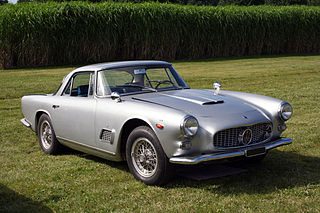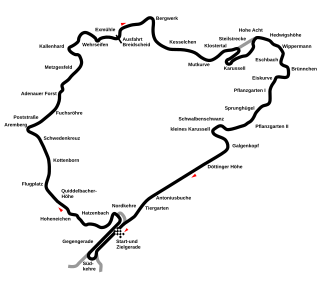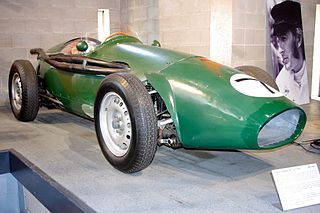
The Albert Park Circuit is a motorsport street circuit around Albert Park Lake in the suburb of Albert Park in Melbourne. It is used annually as a circuit for the Formula One Australian Grand Prix, the supporting Supercars Championship Melbourne SuperSprint and other associated support races. The circuit has an FIA Grade 1 licence.

Maserati S.p.A. is an Italian luxury vehicle manufacturer. Established on 1 December 1914 in Bologna, Italy, the company's headquarters are now in Modena, and its emblem is a trident. The company has been owned by Stellantis since 2021. Maserati was initially associated with Ferrari. In May 2014, due to ambitious plans and product launches, Maserati sold a record of over 3,000 cars in one month. This caused them to increase production of the Quattroporte and Ghibli models. In addition to the Ghibli and Quattroporte, Maserati offers the Maserati GranTurismo and two SUV models, the Maserati Levante and the Maserati Grecale. Maserati has placed a yearly production output cap at 75,000 vehicles globally.

The Mercedes-Benz W196 was a Formula One racing car produced by Mercedes-Benz for the 1954 and 1955 F1 seasons. Successor to the W194, in the hands of Juan Manuel Fangio and Stirling Moss it won 9 of 12 races entered and captured the only two world championships in which it competed.

The Maserati 3500 GT and the Maserati 3500 GT Spyder are 2-door coupé and convertible grand tourers made by Italian car manufacturer Maserati between 1957 and 1964. It was a seminal vehicle for Maserati as the company's first successful attempt at the Gran Turismo market and series production.

{{Short description|Italian racing cars]]

The Maserati 250F was a racing car made by Maserati of Italy used in '2.5 litre' Formula One racing between January 1954 and November 1960. Twenty-six examples were made.

The Maserati 450S is a racing car made by Italian automobile manufacturer Maserati for participating in FIA's endurance World Sportscar Championship racing. A total of nine were made.

Maserati A6 were a series of grand tourers, racing sports cars and single seaters made by Maserati of Italy between 1947 and 1956. They were named for Alfieri Maserati and for their straight-six engine.

Maserati 150S is a racing car made by Maserati of Italy alongside the Maserati 200S, to take over for the aging Maserati A6GCS racing variants. Depending on the source, between twenty-four and twenty-seven examples were built, and one additional street-going car, called the Maserati 150 GT.
The 1956 World Sportscar Championship was the fourth annual FIA World Sportscar Championship. It was a contested by sportscars over a series of five races from 29 January to 12 August 1956.

The Maserati Tipo 60/61 are a series of sports racing cars produced between 1959 and 1961 by Italian automobile manufacturer Maserati for privateers racing in sports car events including the 24 Hours of Le Mans in the 2-litre and 3-litre racing category. It used an intricate tubular space frame chassis, containing about 200 chro-moly steel tubes welded together, arranged triangular formation at high stress areas of the chassis, hence the nickname "Birdcage". This method of construction provided a more rigid and, at the same time, lighter chassis than other racing cars of the time.
Throughout its history, the Italian auto manufacturer Maserati has participated in various forms of motorsport including Formula One, sportscar racing and touring car racing, both as a works team and through private entrants. Maserati currently competes in Formula E in partnership with the Monaco Sports Group (MSG) as Maserati MSG Racing.

The Maserati 250S, and its derivative and version, the 250 Sport, are sports racing cars, designed, developed and built by Italian car manufacturer Maserati, between 1954 and 1957. Only two models were produced.

The 1956 Sveriges Grand Prix took place on 12 August, at the Råbelövsbanan, Kristianstad. Although this was the second running of the race, it was the first time as a round of the F.I.A. World Sports Car Championship. The previous year's race, won by Juan Manuel Fangio was the first big race held in Sweden, and the organiser, Kungl Automobil Klubben dealt with it so well, the F.I.A. promoted the race. For this year's event, the circuit was widened and resurfaced.

The 2. Internationales ADAC 1000 Kilometer Rennen auf dem Nürburgring took place on 27 May, on the Nürburgring Nordschleife,. It was also the fourth round of the F.I.A. World Sports Car Championship. This was the first time the event had taken place, since it was dropped from the championship following its inaugural event in 1953. It was also round two of the German Sportscar Championship.

The Maserati 150 GT was a prototype sports car produced by Maserati in 1957. Derived from the four-cylinder Maserati 150S race car, it was a singular road-going example, and was given spyder bodywork.

The Maserati 420M/58Eldorado was a single-seater manufactured by Maserati in 1958. It was a one-off race car purpose-built for the second edition of the 500 Miles of Monza. It was the first single-seater in Europe to be sponsored by a brand not attached to an automobile industry. The internal Maserati classification was the Tipo 4, behind the 250F variants, and also referred to as the 420/M/58 for 4.2-litre displacement, Monoposto or a single-seater in Italian and 1958 year, or simply as the "Eldorado".
Maserati made two naturally-aspirated, straight-6, racing engines, designed for Formula One; between 1952 and 1960. The first engine was the 2.0-liter A6G; in accordance with the engine regulations imposed by the FIA. Their second and last engine was the 250 F1; in accordance with the engine regulations imposed by the FIA for 1954. Several of these engines, or derivatives of these engines, were also used in various Maserati sports cars.
Maserati made four naturally-aspirated, V12 racing engines, designed for Formula One, between 1951 and 1969. The first was an experimental O.S.C.A. engine, in accordance with the 4.5 L engine regulations imposed by the FIA for 1951. Their second engine was 250 F1 V12, in accordance with the 2.5 L engine regulations set by the FIA. Their last two V12 engines were customer engines supplied to Cooper, between 1966 and 1969. The Tipo 9 / F1 and Tipo 10 /F1, which were both manufactured to the FIA's 3.0 L engine regulations for 1966. One sports car, a modified version of the Maserati 350S, also used V12 engine, with a 3.5 L (210 cu in) displacement, and produced 335 hp (250 kW).

The Connaught Type B was a racing car made by Connaught Engineering of England used in Formula One racing between 1955 and 1958. Although not a success in the Formula One World Championship, it became the first British car since 1924 to win a Continental European motor race when Tony Brooks won the non-championship 1955 Syracuse Grand Prix.
















